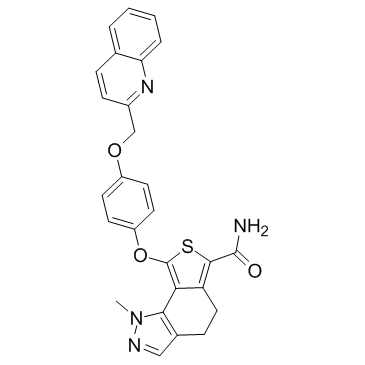TD-198946
Modify Date: 2025-08-22 17:30:29

TD-198946 structure
|
Common Name | TD-198946 | ||
|---|---|---|---|---|
| CAS Number | 364762-86-7 | Molecular Weight | 482.55400 | |
| Density | N/A | Boiling Point | N/A | |
| Molecular Formula | C27H22N4O3S | Melting Point | N/A | |
| MSDS | N/A | Flash Point | N/A | |
Use of TD-198946TD-198946, a thienoindazole derivative, is a potent chondrogenic agent. |
| Name | 1-Methyl-8-[4-(2-quinolinylmethoxy)phenoxy]-4,5-dihydro-1H-thieno [3,4-g]indazole-6-carboxamide |
|---|---|
| Synonym | More Synonyms |
| Description | TD-198946, a thienoindazole derivative, is a potent chondrogenic agent. |
|---|---|
| Related Catalog | |
| In Vitro | TD-198946 is a potent chondrogenic agent. TD-198946 strongly induces chondrogenic differentiation without promoting hypertrophy in cell and metatarsal organ cultures. TD-198946 induces stronger Col2a1 promoter activity than insulin in ATDC5 cells. In C3H10T1/2 cells, ATDC5 cells and primary mouse chondrocytes, TD-198946 dose-dependently stimulates endogenous expression of the chondrocyte markers Col2a1 and Acan, with maximum effects around 1-10 μM[1]. |
| In Vivo | When administered directly into the joint space, TD-198946 successfully prevents and repaires degeneration of the articular cartilage. TD-198946 exerts its effect through the regulation of Runx1 expression, which is downregulated in both mouse and human OA cartilage compared with normal tissue[1]. TD-198946 has disease-modifying effects on progressed osteoarthritis. TD-198946 may prevent the progression of osteoarthritis by acting on the remaining chondrocytes rather than repairing damaged cartilage, it may be most effective as a therapeutic during the early or middle stages of osteoarthritis, before the articular cartilage is fully eroded[2]. Cartilaginous cell-sheets are generated by culturing mouse and canine costal chondrocytes and human mesenchymal stem cells with TD-198946 on temperature-responsive dishes. The transplanted cell-sheets are then successfully used to promote the reconstruction of permanent cartilage, with no evidence of chondrocyte hypertrophy in the knee articular cartilage defects created in mice and canines[3]. |
| Animal Admin | Mice: Each of the prevention and repair models had two groups: (1) TD-198946-treated animals and (2) saline-treated animals. In all the mice tested the left knee joints underwent the operation and the right knee joints are sham-operated. Mice are re-anaesthetised and given a 10 µL intra-articular injection of TD-198946 or saline immediately after surgery (prevention model) or 4 weeks following surgery (repair model) every 5 days for 8 or 4 weeks, respectively[1]. |
| References |
| Molecular Formula | C27H22N4O3S |
|---|---|
| Molecular Weight | 482.55400 |
| Exact Mass | 482.14100 |
| PSA | 120.50000 |
| LogP | 5.96590 |
| Appearance of Characters | light yellow solid |
| Storage condition | -20℃ |
| 2,3-dihydro-1-methyl-5-(methylthio)-1H-pyrrole |
| 1H-Pyrrole,2,3-dihydro-1-methyl-5-(methylthio) |
| 1-methyl-2-methylthio-2-pyrroline |
| 4,5-dihydro-1-methyl-8-[4-(2-quinolinylmethoxy)phenoxy]-1H-thieno[3,4-g]indazole-6-carboxamide |
| 1-Methyl-2-methylthio-2-pyrrolin |
| 1-methyl-5-(methylsulfanyl)-2,3-dihydro-1H-pyrrole |
| 1-methyl-8-[4-(quinolin-2-ylmethoxy)phenoxy]-4,5-dihydro-1H-thieno[3,4-g]indazole-6-carboxamide |
| 4,5-Dihydro-1-methyl-8-[4-(2-quinolylmethyloxy)phenoxy]-1H-thieno[3,4-g]indazole-6-carboxamide |
| 1-methyl-5-methylsulfanyl-2,3-dihydro-pyrrole |
| 4,5-dihydro-1-methyl-2-(methylthio)-pyrrole |
| 1-methyl-2-methylsulfanyl-4,5-dihydro-1H-pyrrole |
| TD-198946 |